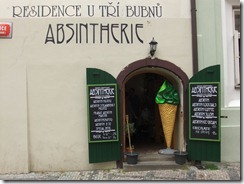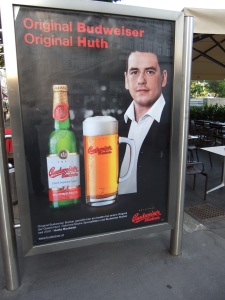Archive
Make the Best of Your Daily Commute by Bus, Subway or Congo Line
“I hate the bus” is something that you hear a lot in Toronto, which is usually backed up with years of bitter anecdotes of delays, weird smells, and poor service. Some of those people eventually break free of the shackles of public transport and opt to instead park themselves behind the wheel of a car. The car is liberating at first, but then it comes with a whole new set of grievances. How many times have you or someone you know said “damn traffic, stupid drivers, idiots, assholes” perhaps even using all four in a single breath. If it sounds like a vicious circle, that’s because it is. Would you feel better about taking public transportation if only the strangers that you encounter would tolerate taking creative liberties with the English language, allowing you to paint the colourful strokes of your emotions on the social canvas like a good ole fashion tar and feathering in the town square?
Probably not, so save your feathers and sanity and opt to instead make the best of the bus with the following tips.
1) Read a book – impossible to do from behind the wheel. Smartphones games are distracting, the memory of a good read will stay with you a long time and will connect to the conversations that you have with friends and family.
2) Learn a language – Download the free app duolingo for your iphone or access their online website if you’re an android/blackberry user. It’s like Rosetta Stone, only free, better and more mobile
3) Podcast – Music is fun for a while but if you’re spending one hour or more in transit, you could stand to learn something from a Ted Talk, Freakanomics Podcast or laugh along with a Comedy Podcast like Comedy Bang Bang or the Dean Blundell Show.
4) Write – If you ride isn’t too bumpy you can finally get to work on that book idea that you’ve been thinking of.
The great thing about being stuck in transit is that you get more distraction-free time to do more time to learn what your learning, read what you’re reading or write what you’re writing. The only thing you get when you’re stuck in traffic is pent up frustrations which can translate into poor language and decisions.
Make the most of the bus, it’s your new classroom. If nothing else, start a Congo line. Strangers will love it.
The Parable of the Mexican Fisherman

I re-posted this parable for a good friend. I hope it causes you to think about doing what makes you happy.
A boat docked in a tiny Mexican village. An American tourist complimented the Mexican fisherman on the quality of his fish and asked how long it took him to catch them. “Not very long,” answered the Mexican.
“But then, why didn’t you stay out longer and catch more?” asked the American.
The Mexican explained that his small catch was sufficient to meet his needs and those of his family.
The American asked, “But what do you do with the rest of your time?”
“I sleep late, fish a little, play with my children, and take a siesta with my wife. In the evenings, I go into the village to see my friends, have a few drinks, play the guitar, and sing a few songs … I have a full life.”
The American interrupted, “I have an MBA from Harvard and I can help you! You should start by fishing longer every day. You can then sell the extra fish you catch. With the extra revenue, you can buy a bigger boat.
“And after that?” asked the Mexican.
With the extra money the larger boat will bring, you can buy a second one and a third one and so on until you have an entire fleet of trawlers. Instead of selling your fish to a middle man, you can then negotiate directly with the processing plants and maybe even open your own plant. You can then leave this little village and move to Mexico City, Los Angeles, or even New York City! From there you can direct your huge new enterprise.”
“How long would that take?” asked the Mexican.
“Twenty, perhaps 25 years,” replied the American.
“And after that?” the Mexican asked.
“Afterwards? That’s when it gets really interesting,” answered the American, laughing. “When your business gets really big, you can start selling stocks and make millions!”
“Millions? Really? And after that?”
“After that you’ll be able to retire, live in a tiny village near the coast, sleep late, play with your children, catch a few fish, take a siesta with your wife and spend your evenings drinking and enjoying your friends.”
Small Town Royalty in Toronto’s Royal Places in Toronto
All but one of you may not necessarily be royalty (yes Queen Elizabeth does frequent this website) but I’m know for certain that the rest of you loyal subjects of her majesty have dreamt of living in a castle. I’m sure it would have been the blissful romantic paradise that you have always imagined, at least, on the outside, but it’s interior promises ample nooks and crannies for dust and unwanted guests. 
Though castle building and royalty may seem like such a European indulgence, Toronto’s got one too so I guess there’s no reason to travel. The timing couldn’t be more perfect. Right around the the time that everyone had stopped building them, destroying them or turning existing ones into museums, the trend caught on in Toronto. We’re a bit slow here in Canada.
Sir Henry Pellat of Toronto started building this castle in 1911 and is remembered as an early leader of the Hydro-Electric Commission in Ontario just when electricity was becoming fashionable and being knighted. He was able to earn enough to fashion this iconic building until sky rocketing income tax rates from $600 to $1000/mo during the ensuing post-WWI depression. The gained a cool new landmark for a cool $27,000 and Sir Henry Pellat had to auctioned off most of his possessions. Projects like his dream roman style bath were unfortunately abandoned and never completed by the city. However, the concrete looks like it was the result of a fine pour.
I don’t regret choosing to live in a 550 sq-ft 1 Bedroom apartment. Nor does visiting make it feel any smaller. I feel that my cozy arrangement is just the right size for the amount of dust bunnies and undesirable guests I need at this stage of my life.
No Risk in Sight
 Once in awhile, I find that I meet someone incredible that changes the way I think. Two weeks ago at an AIESEC conference, I had that experience when I met a man from Lincz by the name of Thomas. Thomas is a remarkable man by any measure. He’s studying to be a lawyer, is incredibly intelligent, great conversationalist, speaks German and English like a native speaker, is good with the ladies, is an accomplished independent traveller and does all of this without being able to see.
Once in awhile, I find that I meet someone incredible that changes the way I think. Two weeks ago at an AIESEC conference, I had that experience when I met a man from Lincz by the name of Thomas. Thomas is a remarkable man by any measure. He’s studying to be a lawyer, is incredibly intelligent, great conversationalist, speaks German and English like a native speaker, is good with the ladies, is an accomplished independent traveller and does all of this without being able to see.
What I find particularly amazing and inspiring is his ability to act without inhibition and accomplish what many us are scared to do even with the ability to see. He is completely independent and travels by himself. He participates in the couch surfing program which allows you to find a stranger’s couch anywhere in the world for a wear traveller to lay his or her head. He’s survived Vegas and China and has plans to travel to many new and exciting places.
I began to reflect on what I typically expect from a vacation and it usually starts with what I want to see. Maybe it’s the beach in Cuba, maybe it’s the historical buildings in Europe or the view from the tops of the alps. In either case there is always a camera involved and a map with a list of things that I need to see. Then the question popped into my head for which I had never given any thought to before:
What is the allure of a vacation for a person without the ability to see and how does that person experience travel?
Admittedly, this is a very narrow minded question but one that I really curious to find out the answer for. For Thomas, it’s 100% about the experience. It’s the feeling of the hot sun on his skin on that same beach in Cuba with a Cuba Libre in hand, it’s the people that he meets and how they receive him as much as it is about doing crazy things like sleeping outside and waking up on a rooftop in Vegas.
He can tell you that story though…
After learning this I get the feeling that our ability to see risk may in fact inhibit us from doing the things we really want to do. What do you think?
Absinthe: Common Sense in a Bottle
In the past, abstinence has occasionally been circumvented by an absence of common sense which has can been traced back to Absinthe. This alcohol laden spirit has it’s origins in Bohemia and has affectionately been dubbed “the green fairy” (la fée verte – en francais) due to it’s hypnotic green glow and the commonly held belief that it causes you to hallucinate. It’s for that reason and it’s apparent addictive nature that it has been made illegal in a host of countries including Canada and the US. While one cannot expect to not be in tip-top condition after consuming a spirit with an alcohol content that can be as high as 80%, you also cannot be held responsible for surrendering to her healthy green allure.
This witches brew is most likely prepared in large boiling cauldrons with several newt’s eyes. One thing’s for sure, it does not contain any added sugar which is the main reason that it is added for a proper serving of the drink. It is served using a decorative spoon, which acts as a glorified strainer, to hold the sugar cube while the Absinthe is diluted over top into the glass. Then it’s down ze hatch.
The culture of the drink appears civilized as evidenced by it’s pouring ritual. However, it seems that young people have a way of pushing the limit on extremes and civil can turn evil in minutes. This particular fairy may dress in sheep’s clothing and as a caution, she will fight you if provoked. Just stay away from mirrors and make sure to keep your belt tightly fastened around your waist.
Leberkäse: The Cheese Saga Continues
If you’re not yet convinced of the incredible gifts that cheese continues to offer us on a daily basis then you’ve not been introduced to the lovely leberkäse which when strictly translated means liver cheese. It’s more of a type of ham meets cheese for some sort of mischievous meatloaf type deal. The secret ingredients are corned beef, pork, bacon and onions and is prepared by grinding everything up and then baking it like a loaf in a bread pan until it has a crunchy brown crust. The reason that this is important is because it serves as further proof that the asymptote that is used to graph flavour is not in fact infinite and will eventually meet with the axis of culinary perfection. Whatever the dish may be, I can guarantee that cheese will be there.
It’s a simple warm sandwich and requires little effort to order. It is available at most bakeries and grocery stores in Austria. If you wish to order one of these tantalizing treats on a kaiser-like bun simply say “Leberkäse mit semmel, bitte”. They’ll undoubtedly recognize that you have a german language deficiency and help you by marking a common thickness on the loaf. Nod your head or ask for thicker and you’re on your way. The kind server will weigh it and prepare your sandwich “mit senf” (with mustard) if you fancy.
The sandwich is quite inexpensive averaging about 2€ per sandwich. Unfortunately, I do not have the nutritional information which is probably because there is none to speak of. In what it takes away from your body in terms of digestive no-goodery it makes up for in flavour. It’s one of the only “meats” that I know of that handles well enough on it’s own with bread which makes most other sandwiches seem high maintenance with all their necessary toppings like vegtables, ugh.
Käsekrainer: A Testament to the Ductility of Cheese
There are few things that I care about more in this world than cheese. It is a topping synonymous with the Canadian national identity when coupled with gravy and French fries. It is a friend of crackers everywhere and puts a smile on the faces of children across the globe. After years of hard work as a topping and a track record of proven results it appears clear that cheese needed take it to the next level. Enter stage right: the Käsekrainer.
The Käsekrainer is a sausage that is 10-20% cheese and was invented in Austria during the 1980’s according to Wikipedia. They are evidently a staple of every Würstelstand in Vienna and may be an essential part of your bar night ritual.
At first glance it may appear trivial that I’m wasting your precious time writing about a cheese sausage but I want you to consider just how incredible this concept is. Someone decided, probably mid dinner-time sausage, that regular sausage just wasn’t good enough and that we the people deserve more from our pink bellied animal friends. We decided that after we’ve killed poor babe the pig that we’d grind up his insides to be stuffed inside a tube along with a product we’ve prepared from his good friend and lifelong ally, Molly the cow. Could we possibly dominate a species more than this?
It seems bizarre that this type of meal-time innovation has become accepted every where with no real thought into why it is necessarily exists or that it just seems plain rude. It’s a good thing that this doesn’t bother me because even though they look disgusting, they’re damn delicious!
This song translates to “everything has an end and a sausage has two” which is why I’m leaving you. The story follows that a man decides to end his marriage simply based on this idea. The video is quite cheeky. Enjoy!
This Bud’s for you…
The evidence of American cultural imperialism is littered across much of the modern world. No matter where you are, it seems as though you are never too far from a McDonald’s Big Mac, a cold delicious Coca-Cola, and you’ll be looking dapper in your Abercrombie & Fitch t-shirt if you’re careful not to spill. I’m both amazed at how seamlessly international corporations have exported their brands across the world by changing a few ingredients in their recipe for success and perplexed that visible brand imperialism has not been met with more resistance. While Vienna still has a very unique flavour to it’s cultural identity and much more that I have yet to experience, it seems that there has been slight move to a sort of global homogenization of culture.
California’s movie making factory is churning out relatable idioms that resonate across an entire generation of youth. Many of us integrate these expressions into our communication style and they seem to generate a feel good moment when the person you just met “gets it.” I was able to make a connection and a new “friend”, if I can be so bold in the assumption, over the movie Eurotrip. He told me that “It’s a good thing I came in Summer because in Winter it can be very depressing” and I made sure that I was polite to say ” Mi Scusi” if I had to slip by him. Even in countries that are geographically so distant, the powerful force of globalization and effective word-of-mouth brings us together in a rather peculiar way.
From what I have observed so far, I was not surprised to learn of one of the earliest trademark disputes in the world’s history involved the United States. The dispute was between Anheuser-Busch and the Czech Republic producer, Budvar, over who owns the trademark and the right to sell Budweiser Beer. After reviewing the American Budweiser.com I noticed that the Anheuser-Busch makes no reference to the trademark dispute but instead claims that in 1876 Adolphus Busch pioneered brewing the better way. The Budweiser.at website claims that the beer’s roots date back to 1265 and makes explicit reference to the dispute. The EU has ruled that Anheuser-Busch can sell it’s version of the brand under the name Bud and the United States will allow import of the Czech brand under the name Czechvar.
In the meantime I don’t like to argue, let’s ignore the barrage of advertisements and visual stimuli. Let’s instead enjoy a delicious pint, strudel type treat, and take in the experience and enjoy the view. Prost!
Walking is so old school
In Vienna, they have they have a brand of walking called nordic walking which is apparently much better than the old fashioned way. I stumbled across this on a beautiful day out in the city. I first say two women of the sort in the picture below walking with what looked like ski poles in each hand. At first I dismissed it as simple way to transport a set of ski poles across a walkable distance. I also admired them for their bravery to integrate it into their walking regimen. One can only hope that you integrate whatever object that you’ve been charged with carrying into your unique brand of gait.
In all seriousness this appears to be a good idea to improve posture and is especially effective for anyone suffering from Osteoporosis and other joint related ailments. I’ve just never seen anything of the sort in Canada, we just use our plain old boring legs. Perhaps it’s time for a change. The product boasts posture improvement and a calorie burn rate that is 33% more effective than normal walking.
Image Source: http://urbanpoling.com/pages/nordic-walking-made-easy?gclid=CMj4g5LK1agCFRof3wod_iPZQw








Recent Comments